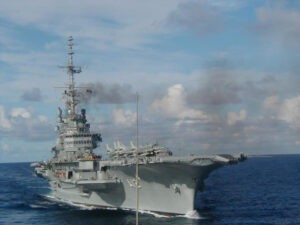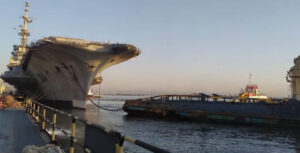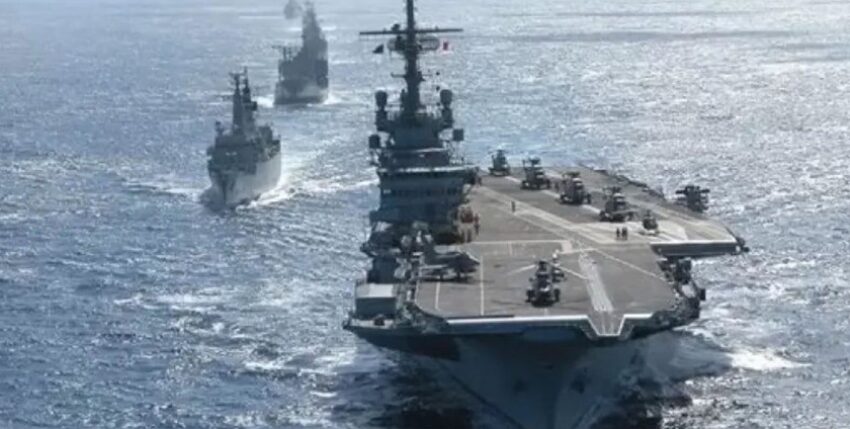Update from 5 February 2023
And it happened like you could have counted on five fingers: On 4 February 2023, around 190 nautical miles (350 kilometres) off the coast - just inside the Brazilian economic zone - the Brazilian navy sank the contaminated scrap carrier "Sao Paolo", which had been drifting in the Atlantic for months, in a controlled manner at a water depth of 5,000 metres, free of underwater cables and protection zones. There was "no alternative" - due to the high risk of the ailing, leaking ex-flagship sinking uncontrollably at any time.
Environment - doomed to failure
The only astonishing thing is that even after the change of government in Brazil, there was not enough political space for a more environmentally friendly solution to the "scrapping". One day before the targeted torpedo fire, the Attorney General's Office had demanded that the government prohibit the scrapping for environmental reasons (including around 10 tonnes of asbestos insulation) and, in accordance with the Ministry of the Environment's demand, if the carrier could no longer be kept afloat as a tug and tow, it should at least be repaired in such a way that it could be "decontaminated" in accordance with the law.

Previous history (see below)
The Brazilian Navy acquired the carrier, built in 1963 as the "Foch", from France for 12 million dollars in 2001, but as a flagship flying the green and yellow flag, it was only used for a short time at sea. In the summer of 2022, it was auctioned off to a Turkish scrapping company for two million dollars and sent on its way there without the required information on the scope and quantity of hazardous substances on board - whereupon Turkey refused to accept it and Spain and Morocco prohibited its entry into the Mediterranean. The tugboat turned back, was observed by Spain as it passed the Canary Islands - and was then no longer officially seen.
France part
But France also has to put up with unpleasant questions, as it has missed a good opportunity to reach out to Brazil responsibly and make concessions on the disposal of the (originally French) pollutants.
Rubbish everywhere
In any case, Brazil has a huge problem with shipwrecks in its coastal waters: In Guanabara Bay alone, inland from Rio de Janeiro, there are hundreds of abandoned ships - large and small - more or less laden with oil and lubricants - more underwater than above water - hidden at the edges of the mangrove forests or simply abandoned and anchored in the bay. Aerial photographs show rusting outlines of ships and shimmering oil film everywhere. Since a pipeline burst in 2000, releasing well over a million litres of oil into the waters, the forests have not been able to recover despite reforestation measures and are retreating in a huff. The once flourishing life on and under the water is now just wasting away. Of course, the continuing untreated discharge of 70% of wastewater from the metropolis of 12 million people into the bay is also of little help. And the world's largest landfill site "Jardim Gramacho", located on an island at the western end of the bay, was only closed in 2012 - which unfortunately also meant the loss of 1700 jobs for the "garbage pickers".
Conclusion
But where to put all the rubbish - on land and at sea? Sink it, said the government - at least then you won't see it any more - and soon it will be forgotten!
Original article from 26 August 2022

The aircraft carrier was commissioned in 1963 under the name "Foch" by the Navy Nationale, then passed on to Brazil at the end of 2000 after 37 years of service, but could never be properly restored to operational readiness there as the flagship "Sao Paolo", so it left service in 2017 and was finally auctioned off to a Turkish shipyard in Aliaga (north of Izmir) for scrapping.
Concentrated load of poison
It can be assumed that there is plenty of hazardous material in and on the ship, such as asbestos, PCBs and toxic paints, which qualify the hull as hazardous waste under international law and it is therefore subject to special trade restrictions. In addition, the ship had been subjected to atmospheric nuclear bomb tests in the Pacific in 1966. For this alone, around 170 tonnes of lead and cadmium paint were applied as radiation protection. Furthermore, there were probably also nuclear substances on board in French times, about which very little information is available.
International rules
But there is an IHM list, an Inventory of Hazardous Materials, which had to be drawn up before the Brazilian carrier was exported. However, the Turkish side does not trust this paper from the Brazilian navy at all, as it was unable to inspect it and could not inspect more than 10% of the carrier, and is now demanding further sampling and tests to determine the exact pollutant content. In addition, environmentalists in both countries are sounding the alarm because, according to the Basel and Barcelona Conventions, exports are not allowed to take place under these circumstances. Accordingly, the Turkish Supreme Court has issued a temporary injunction prohibiting the import of the "Sao Paolo" to Turkey and has demanded testing within Brazilian territorial waters.
Example Clemenceau
As the original owner of the "Foch", France had the final say on any resale - even as a wreck - in accordance with the 2000 purchase agreement. Paris explained to Brazil that only EU shipyards on the list of approved ship recycling facilities were allowed to bid, as stipulated in the 1996 Izmir Protocol to the Barcelona Convention (Protocol on the Prevention of Pollution of the Mediterranean Sea by Transboundary Movements of Hazardous Wastes and their Disposal), according to which no hazardous waste may pass through the Mediterranean - except for disposal in an EU country. Various environmental organisations are now calling for France to intervene, as in the case of the sister ship "Clemenceau", which was exported to India in 2006 and was brought back to France by President Jacques Chirac due to the illegality of the procedure.
Brazil's brazen approach
However, Brazil sent the tug with the carrier on its journey to the Mediterranean at the beginning of August. It immediately left the planned route along the Brazilian coast and travelled straight eastwards into international waters. Brazil now believes it no longer has to comply with the Turkish order. The tug is now off the coast of Mauritania, a few days' sail from Gibraltar, but neither Morocco, Spain nor the UK have been notified or have given their consent to the passage of waters, as would have been required under the Basel Convention. Brazil therefore shamelessly proposes to have the new tests carried out "on arrival" in Turkey - incidentally also at the expense of the importer. Turkey rightly refuses, as this approach would be a deliberate breach of international law - it is demanding the return transport to Brazil and a closure of the Mediterranean to this tug.
All's well that ends well - all rubbish
Some nations will now probably take action against the tug and the drama will take its course under the eyes of the world. If Brazil does not give in and no other nation backs down, the tug will turn back at Gibraltar in a huff and start its journey home. Any bets that it will never get there? The weather conditions in an Atlantic bad weather front will cause the hawser to break - and the pollutant giant will go deep. Brazil will portray itself as the victim and will see itself free of all blame. The Brazilian president will care little. You bet?











5 responses
Now the ship has actually sunk - a few hundred kilometres off the Brazilian coast at a depth of several thousand metres
You wouldn't think it possible. Back in 2013, France failed in its attempt to have the sister ship "Clemenceau" scrapped in India because of the asbestos content. This was followed by an embarrassing return to Brest. (https://www.tagesspiegel.de/politik/die-odyssee-der-clemenceau/685202.html)
How rotten is our world now? I can't understand why France doesn't have to dispose of its own scrap metal. If I just leave my scrap car to rot on my property, the public order office will be there immediately.
The only people still interested in the ship are likely to be Indians or the Chinese - the latter to study, as with the HMAS Melbourne. If the ship changes ownership and destination harbour several times at sea, I wouldn't be surprised to see such an offer.
And apart from that - the route around the Cape through the Indian Ocean is much longer than back to Brazil. So the chance of a really strong bad weather front is even greater.
That's really cool! I can't wait to see what happens next. I hope you'll report back ...